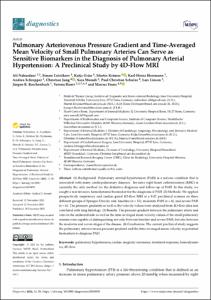Pulmonary Arteriovenous Pressure Gradient and Time-Averaged Mean Velocity of Small Pulmonary Arteries Can Serve as Sensitive Biomarkers in the Diagnosis of Pulmonary Arterial HypertensionA Preclinical Study by 4D-Flow MRI

Pulmonary Arteriovenous Pressure Gradient and Time-Averaged Mean Velocity of Small Pulmonary Arteries Can Serve as Sensitive Biomarkers in the Diagnosis of Pulmonary Arterial Hypertension
A Preclinical Study by 4D-Flow MRI

| dc.contributor.author | Nahardani, Ali | |
| dc.contributor.author | Leistikow, Simon | |
| dc.contributor.author | Grün, Katja | |
| dc.contributor.author | Krämer, Martin | |
| dc.contributor.author | Herrmann, Karl-Heinz | |
| dc.contributor.author | Schrepper, Andrea | |
| dc.contributor.author | Jung, Christian | |
| dc.contributor.author | Moradi, Sara | |
| dc.contributor.author | Schulze, Paul Christian | |
| dc.contributor.author | Linsen, Lars | |
| dc.contributor.author | Reichenbach, Jürgen R. | |
| dc.contributor.author | Hoerr, Verena | |
| dc.contributor.author | Franz, Marcus | |
| dc.date.accessioned | 2023-02-08T06:47:23Z | |
| dc.date.available | 2023-02-08T06:47:23Z | |
| dc.date.issued | 28.12.2021 | |
| dc.identifier.uri | https://hdl.handle.net/20.500.11811/10621 | |
| dc.description.abstract | (1) Background: Pulmonary arterial hypertension (PAH) is a serious condition that is associated with many cardiopulmonary diseases. Invasive right heart catheterization (RHC) is currently the only method for the definitive diagnosis and follow-up of PAH. In this study, we sought a non-invasive hemodynamic biomarker for the diagnosis of PAH. (2) Methods: We applied prospectively respiratory and cardiac gated 4D-flow MRI at a 9.4T preclinical scanner on three different groups of Sprague Dawley rats: baseline (n = 11), moderate PAH (n = 8), and severe PAH (n = 8). The pressure gradients as well as the velocity values were analyzed from 4D-flow data and correlated with lung histology. (3) Results: The pressure gradient between the pulmonary artery and vein on the unilateral side as well as the time-averaged mean velocity values of the small pulmonary arteries were capable of distinguishing not only between baseline and severe PAH, but also between the moderate and severe stages of the disease. (4) Conclusions: The current preclinical study suggests the pulmonary arteriovenous pressure gradient and the time-averaged mean velocity as potential biomarkers to diagnose PAH. | en |
| dc.format.extent | 13 | |
| dc.language.iso | eng | |
| dc.rights | Namensnennung 4.0 International | |
| dc.rights.uri | http://creativecommons.org/licenses/by/4.0/ | |
| dc.subject | pulmonary hypertension | |
| dc.subject | cardiac magnetic resonance | |
| dc.subject | treatment response | |
| dc.subject | hemodynamics | |
| dc.subject | 4D-flow | |
| dc.subject.ddc | 610 Medizin, Gesundheit | |
| dc.title | Pulmonary Arteriovenous Pressure Gradient and Time-Averaged Mean Velocity of Small Pulmonary Arteries Can Serve as Sensitive Biomarkers in the Diagnosis of Pulmonary Arterial Hypertension | |
| dc.title.alternative | A Preclinical Study by 4D-Flow MRI | |
| dc.type | Wissenschaftlicher Artikel | |
| dc.publisher.name | MDPI | |
| dc.rights.accessRights | openAccess | |
| dc.relation.eissn | 2075-4418 | |
| dcterms.bibliographicCitation.volume | 2022, vol. 12 | |
| dcterms.bibliographicCitation.issue | iss. 58 | |
| dcterms.bibliographicCitation.pagestart | 1 | |
| dcterms.bibliographicCitation.pageend | 13 | |
| dc.relation.doi | https://doi.org/10.3390/diagnostics12010058 | |
| dcterms.bibliographicCitation.journaltitle | Diagnostics | |
| ulbbn.pubtype | Zweitveröffentlichung | |
| dc.version | publishedVersion | |
| ulbbn.sponsorship.oaUnifund | OA-Förderung Universität Bonn |
Files in this item
This item appears in the following Collection(s)
-
Publikationen (2)




